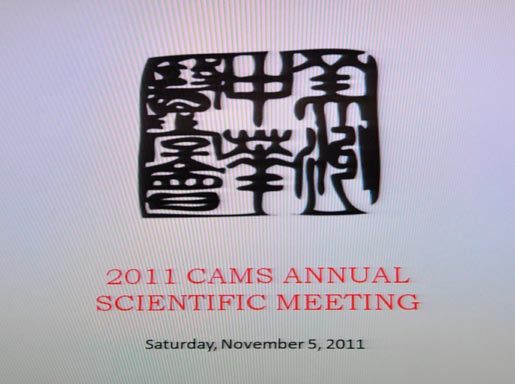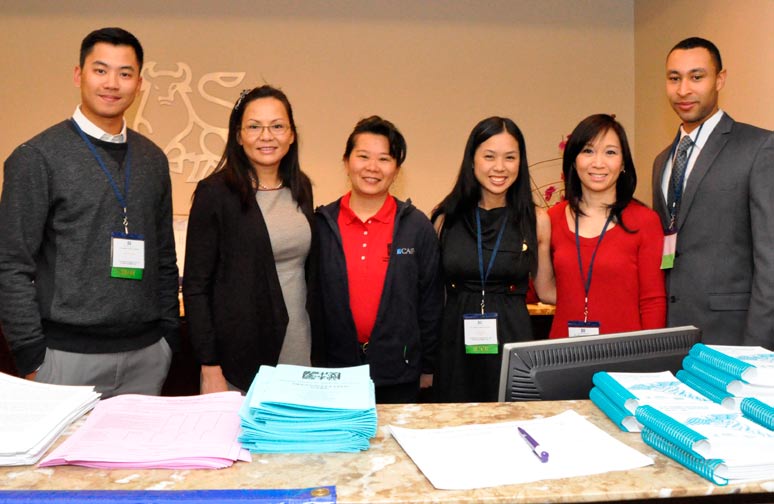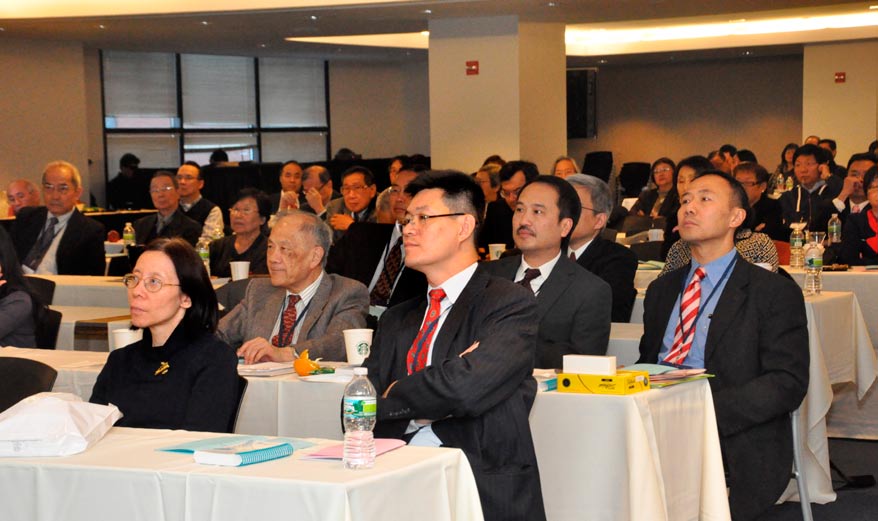Chineseamericanmedicalsociety.cloverpad.org








Chinese American Medic S
al Society
2011 Scientific Meeting and Gala
The Chinese American Medical Society had by Dr. Albert Siu, M.D, M.S.P.H., Elen & Howard included osteoporosis prevention, smoking cessa-
our 48th Annual Scientific Meeting on No-
C. Katz Chairman and Professor of Geriatrics and
tion, treatment of depression, future of arrhythmia
vember 5, 2011 at the Merril Lynch Confer-
Pal iative Medicine at the Mount Sinai School of
management, PSA screening, lung cancer screening,
ence Center at 250 Vesey Street at 4 World Financial
Medicine & Director of Geriatric Research, Educa-
genomics, breast cancer screening and gynecological
Center. The theme this year was "A Symposium on
tion & Clinical Center at Bronx VA Medical Center.
cancer screening. Summaries of al the presenta-
Preventive Care" with 6.5 Category I CME credits
The Keynote Speaker was Dr. Thomas Tsang M.D,
tions are printed in this issue. The Conference was
sponsored by New York Downtown Hospital. The
M.P.H., Senior Advisor to the Governor of Hawaii
very wel received and we had a record 206 people
symposium provided the most up-to-date informa-
on Health Care Transformation, who gave a very
registered for the meeting. This year we welcomed
tion on preventive care that is relevant to the practice
informative talk on "Health and Wel ness - An Up-
22 Chinese American Nurses Association members,
of physicians, nurses and health care providers that
date on Innovations and Policies." This year's very
22 Myanmar American Medical Education Society
treat Chinese American patients in our community.
successful conference was organized by the Scientific
members as wel as three visiting professors from
USB drives containing the lecture slides were given
Program Chair, Dr. Paul C. Lee and his committee,
China. Seven posters were in display. For competi-
to the conference participants. The Scientific Award
who have amassed faculty speakers local y as wel as
tion (students and residents,) the First prize went to
Lecture "How to Live to 100 and Beyond" was given
from Maryland, California and Canada. The topics
Calvin Yu and the Second prize to Vanessa Li.
CAMS logo on the big screen
From left, Drs. Paul C. Lee (Program
Chairman), Raymond Yung (in-coming
President of CAMS), and Warren Chin
The audience
Dr. Blanche Leung (second from right)
with the registration crew From left, Nick
Lam, Peggy Sheng, Zoe Tsai, Jamie Love
and Nat Love at the right end
The posters
At the registration desk
The exhibits
CAMS Newsletter December �011
Dr. Albert Siu giving the Scientific
Dr. Siu receiving the certificate of CAMS
Honorary Member from Dr. Paul C. Lee
Dr. Siu receiving the CAMS Scientific
Award from Dr. Lee.
Dr. Victor Chang
Our photographer Bob Schneck and Ms. Cora Fung
Dr. Thomas Tsang giving the keynote speech
Drs. Thomas King and Sun-Ho Foo
Drs. Percy Tung and Florence Chu
Drs. Wilson Ko and Danny Fong
CAMS Business Meeting
During lunch, the CAMS business meeting an update on their activities in Albany and also The next CAMS president Dr. Raymond Yung was
was held. President Dr. Warren W. Chin
reported on the passing of Dr. Daniel W. Lee. The
also introduced and welcomed. The amendments to
reported the operating budgets and the
Greater Boston Chapter representative Dr. Gifford
the by-laws were passed. In essence, the by-laws now
expenditures of the CAMS-CAIPA Community
Lum reported on their activities and future plans.
state clearly how a board member can run again after
Service Fund. The Membership Chair, Dinner &
serving 2 terms, and the role of the Emeritus mem-
Fund-raising Chair and Social Chair Dr. Blanche
The result of the election was announced and Dr.
ber is described. Also, Chapter members should
Leung, the Research Chair Dr. Victor Chang, the
Danny Fong will be the next Vice President, Dr.
collect membership dues but need not pay any to
Program Chair Dr. Paul C. Lee, the Website Chair
Blanche Leung the next Secretary, Dr. Paul C. Lee
Headquarters. There was also a presentation by Mr.
Dr. Richard Chan and the Finance Chair Dr.
the next Treasurer and Drs. Alex Jenny Ky, Mary F.
Ted Fang, Director of Asian Week Foundation on
Raymond Yung gave reports of their committees.
Lee-Wong (incumbent), Bing Lu and Perry Pong
the Hep B Free Campaign in San Francisco and how
The Capital District President Dr. Mina Sun gave
(incumbent) were elected as Directors of the Board.
this campaign can be brought to the East Coast.
CAMS Newsletter
For the fourth year, the CAMS-CAIPA Red acknowledge and offer regrets for the passage of
Lantern Gala was held at Cipriani Wal Street.
the Chinese Exclusion Act of 1882. The award was
This signature gala has become more and
accepted by her Chief of Staff Ms. Amelia Wang. Dr.
more successful every year. We had a record crowd
David T.W. Chiu also announced the first CAMS
of 588 guests at the gala this year. Dr. Warren W.
Lifetime Achievement Award to honor our Execu-
Chin, President of CAMS and Dr. George C.K.
tive Director, Dr. Hsueh hwa Wang, for her tireless
Liu, President of CAIPA gave welcoming speeches.
efforts, dedication and unwavering commitment
The entertainment included performances by
to CAMS and the Chinese American community
Cirque-Tacular and Salsa Dancers. The 2011 CAMS
over the last forty years. CAMS also acknowledged
Community Service Award was presented by Dr.
Dr. Percy Tung, CAMS' very first Vice President
David T.W. Chiu to the Honorable Congresswoman
in 1964-1966 and second President in 1966-1968
Judy Chu, the first Chinese U.S. Congresswoman,
and his wife Dr. Florence Chu, CAMS' very first
for her dedication as well as for her introduction
Secretary from 1964-1968, for their continued
of House Resolution 282, which would formally
support and contribution of CAMS. The 2011
CAMS-CAIPA Community Physician Service
Awards were presented to Drs. Hong Liu, Kwok
Changing of the guard, Dr. Warren Chin (right)
holding the medallion from Dr. Raymond Yung (Left)
Yung Miu and Peter Y. Ng for their long-standing
service to our community.
Ms. Amelia Wang, flanked by Drs. David Chiu
and Warren Chin, accepting the 2011 CAMS
Community Service Award for Congresswoman
The honorees of 2011 CAMS/CAIPA Community Physicians
Jamie Love and Cora Fung in front of
Award, from left, Drs. George Liu, Raymond Yung, Kwok Yung
the tables with red lanterns
Miu (Honoree,) Warren Chin, Thomas Tsang, Peter Y. Ng
(Honoree,) Benjamin Peng, and Hong Liu (Honoree)
The dazzling tables
The acrobats
MC June Jee
From left, Mrs. Warren Chin (Betty,) Jennifer Chin (daughter of
Dr. Chin - her first coming-out!) Dr. Warren Chin, Ms. Amanda
Smolen, Erika and father Dr. Winston Tom
CAMS Newsletter December �011
At The University Club
CAMS Members Honored: Dr. Warren Chin received
the Community Physician Leadership Award from the
Visiting Nurse Service of New York on October 18, 2011
and an Award from the Philippine Chinese American
Medical Association (PCAMA) on November 26, 2011
at their post-Thanksgiving party (Photo below.) Earlier
this year, on July 9, 2011, at the 17th Anniversary of
their dinner gala, Dr. David Chiu was honored by
Dr. Wang and her family - back & flanking her, son John, his wife Lisa and daughter Stephanie. On her left,
daughter Janet with her husband David Harris at her back, and daughter Mae with John New at her back
Dr. Chin receiving the award from Dr. Edwina Kho (left)
and Brian O'Yong president of PCAMA (left)
PCAMA as the world's most famous plastic surgeon.
Dr. Chin also accepted an award given to CAMS by the
Myanmar Medical Education Society at their Annual
Conference on July 24, 2011.
A Party for Dr. Hsueh hwa Wang by the Board of Di-
rectors of CAMS was held on October 21, 2011 at The
University Club in New York City to present her with
the Lifetime Achievement Award because she was unable
to accept the Award at the Annual Scientific Meeting.
The party, arranged by Dr. David Chiu, was attended
Dr. Hsueh hwa Wang flanked by Drs. David
Dr. K.C. Wang, schoolmates from
by many Board members and their families as well as
Chiu and Warren Chin
old medical school
several past CAMS Presidents. Drs. Percy Tung and his
wife Florence Chu, founders of CAMS also were there.
Dr. Wang was particularly touched by the presence of
all her 3 children with their spouses or significant other
(some came from afar – California and Virginia) plus
one grand daughter who is a Columbia College senior.
It was a roaring party of about 70 people at dinner, and
many, many speeches.
New Quarters for CAMS Office: CAMS has been
cramped in a small room inside the CAIPA office for
years. Our Administrator Jamie could barely turn around
among the stored boxes. The good news is that we have
negotiated to move to the 6th floor of the current build-
ing, stil sharing spaces with CAIPA but with more room.
With some good friends - from left, Drs. Lilian
Hopefully the move can be made in early 2012.
and David Chu, Mrs. and Dr. Warren Chin, Dr.
Chun K. Yip with Mrs. John Wang (Susie) at his
Educational Tour: Dr. Yun-His Hsu is arranging an-
back, Dr. Wang, Dr. Sam Yeh, Dr. John Wang and
Dr. Sun-Hoo Foo
other Educational Tour which he cal s "ASIA – Oriental
Enchantment," 12 nights from 3/4 to 3/14, 2012. You
will cruise from Shanghai to Hong Kong via Pusan
The crowd at The University Club
(Korea), Hiroshima, Kobe, Kagoshima (Japan), Keelung
and Hualien (Taiwan), finally disembarking in Hong
Kong. Tour price is $2,819 pp double occupancy plus
air fare ($799 from east and $499 from west cities.) For
reservation and information, call A & C Travel Agency
at 212-714-3557, or 800-943-0186.
In Memoriam: We mourn the passing of Dr. Daniel
W. Lee, on August 26, 2011. Dr. Lee, endocrinologist,
Associate Professor of Medicine at Albany Medical Col-
lege, was a long-time devoted member of CAMS, Albany
Chapter. Dr. Lee passed away suddenly on 8/26/2011
at the age of 53. We will miss him.
CAMS Newsletter
What to do to live to 100? And what should we do differently since many will live to 100?
Albert Siu, M.D.
We have witnessed a steady improvement in life to take is to adhere to current lifestyle and clinical prevention guidelines. Although there
expectancy in industrialized nations that has been
has been interest in caloric restriction and pharmacologic interventions to mimic the ef-
sustained over more than a century. These improve-
fects of caloric restriction, the evidence on these approaches remains too preliminary to
ments in life expectancy have been so sustained over time that it
recommend wide adoption at this time.
is not likely to be due to any single medical or public health ad-
vance. It can be argued that improved life expectancy has been
Finally, we should consider what should be done differently, knowing that many, and
due to a combination of prosperity, which has made possible
especially our children, will live to 100. This will require changes in the Medicare pro-
increased access to health care and investment in biomedical
gram to make it fiscally sustainable, as well as reconsidering our notions of continuing
sciences, coupled with a more educated populace that is able to
education, careers, and time for family and leisure through the lifespan. These are the
sort through the information on how to improve health.
chal enges we face as we prepare for a society where living to 100 goes from being a novelty
At a societal level, to sustain the improvements in life expectancy into this century, we
to being commonplace.
should endeavour to continue the investments in biomedical science, in education, and in
Dr. Siu is Ellen & Howard C. Katz Chairman and Professor of the Brookdale Department of
health care access that made the improvements of the last century possible. At an individual
Geriatrics and Palliative Medicine at the Mont Sinai School of Medicine and The Director of
level, if one wishes to maximize their chance of living to 100, the most reasonable course
Geriatric Research, Education and Clinical Center at the Bronx VA Medical Center.
The Future of Arrhythmia Management
Paul J. Wang, M.D,
Sudden Cardiac Death
Devices to Treat Heart Failure
There are over 1,000 deaths per day in the U.S. alone
Cardiac resynchronization therapy devices act by pacing the left and right ventricles in a
due to Sudden Cardiac Death. Survival from Sudden
coordinated manner so that there is a greater efficiency of ventricular contraction. This
Cardiac Death decreases by 10% with every minute from its
therapy has been shown to reduce heart failure hospitalization and decrease overal mortal-
onset to successful defibrillation. The most common causes
ity. There are new sensors being developed that may significantly improve the ability to
of Sudden Cardiac Death include coronary artery disease and
monitor intracardiac pressures and cardiac function.
left ventricular dysfunction. Other conditions causing Sudden
Cardiac Death include idiopathic dilated cardiomyopathy,
hypertrophic cardiomyopathy, right ventricular dysplasia,
Ventricular tachycardia may be treated with ICD therapy. However, patients receiving
anomalous coronary arteries, long QT, aortic aneurysm, Bru-
multiple shocks for ventricular tachycardia may need to be treated with antiarrhythmic
gada Syndrome, idiopathic VF, and Commotio Cordis. The principles in prevention and
medications or catheter ablation which kills the cells responsible for initiation or perpetu-
treatment of Sudden Cardiac Death begin with prevention of the underlying disease such
ation of ventricular tachycardia.
as coronary artery disease leading to myocardial infarction. Interventions such as treatment
of hypertension, diabetes, hyperlipidemia, and obesity are critical in preventing coronary
artery disease. Prevention of Sudden Cardiac Death may also be achieved by identifying
Atrial fibrillation is the most common arrhythmia, occurring in over 2 million people in
patients at increased risk. Once this patient population is identified it may be possible to
the U.S. alone. Atrial fibrillation is associated with an increased risk of stroke and may
decrease the likelihood of the arrhythmias. Drugs such as beta-adrenergic antagonists or
significantly impair quality of life of patients. There have been major advances in the
angiotensin receptor blocking agents may decrease Sudden Cardiac Death. Because of the
ability of catheter ablation to treat atrial fibrillation. Advances in the future will require
high mortality associated with Sudden Cardiac Death, improving the ability to convert
that we understand the mechanisms better, have improved methods of lesion assessment,
ventricular tachycardia or ventricular fibrillation is critical. The use of an implantable
better methods of imaging and visualization of anatomy, better catheter control systems,
cardioverter defibrillator (ICD) has been shown to significantly improve survival follow-
ing Sudden Cardiac Death. The Automatic external defibrillator, which is designed for
better Mapping, and reduce lesion formation.
layperson use to automatically detect ventricular tachycardia/ventricular fibrillation and
Dr. Wang is Professor of Medicine and Director of Electrophysiology and Arrhythmia Services,
shock the patient, has led to improved survival from Sudden Cardiac Death.
Vivian Ota Wang, Ph.D.
T he discussions focused on the advances in genomics based on family studies of individuals with rare phenotypes, or twin and adoption herita-
research, and new developments in technology and
bility studies, linking genes to phenotypes has evolved to identifying the DNA sequence
analytical tools, have increased the understanding
using whole genome sequencing methods. As another way of understanding health promo-
(and misunderstandings) between phenotypes and genotypes
tion, and disparities, the study of functional epigenomic elements, where environmental
of medically and socially important diseases. Some of these
factors biochemically influence gene expression, without changing the DNA structure,
improvements have increased the accuracy and resolution of
may provide a way of understanding the applications of gene-environment interaction
genomic sequencing, thus reducing the time and costs for
understanding gene-environment interactions of complex
research and its' clinical applications.
diseases and behaviors by making them more affordable and
Dr. Ota Wang is Member of National Genome Research Institute, National Institute of Health,
scientifically within reach. Unlike traditional genetic research
Department of Health and Human Services.
Prostate Cancer Screening and Management
Marcus Loo, M.D.,
Prostate cancer screening with prostate specific antigen However, prostate cancer is the second leading cause of cancer related death among men
(PSA) is one of the most controversial topics in contem-
behind lung cancer with 32,000 deaths in 2010. The American Urological Association
porary medicine. This is because of the concern of over
recommends that early detection and risk assessment of prostate cancer should be offered
diagnosis and over treatment. Despite the recent publication of
to asymptomatic men 40 years and older with an estimated life expectancy of more than
randomized controlled trials, there is still no consensus regard-
10 years who wish to be screened. Issues related to increasing PSA sensitivity, specific-
ing the absolute benefits and risks of early detection strategies.
ity and the use of age specific reference ranges, PSA velocity, free-total PSA to improve
Complicating matters is the recent recommendation by the
sensitivity and specificity are discussed.
United States Preventative Services Task Force that healthy men
Dr. Loo is Clinical professor of Urology, Weil Cornel Medical Col ege and Attending Urologist,
should no longer receive a PSA test to screen for prostate cancer.
New York Presbyterian Hospital.
CAMS Newsletter December �011
Lung cancer screening – What is new in 2011
Paul C. Lee, M.D.
Lung cancer is a deadly disease worldwide and in the than survival rates predicted by the current staging system or among those presenting as
United States, with more than 85% of diagnosed pa-
a result of symptoms.
tients dying of the disease. This is primarily due to the
fact that majority of patients with lung cancer present with
The National Lung Screening Trial (NLST) is a NCI sponsored randomized control
local y advanced and/or metastatic disease. Screening high risk
trial, and the ground breaking results have just been reported in New England Journal of
individuals and identifying patients with early stage lung cancer
Medicine this year. In this study, 26,722 participants were randomized to receive three
with resectable and potential y curable disease, may reduce the
annual screens with low-dose helical CT scan, and 26,732 were randomized to three
overall death rate from lung cancer. In the 1970s, randomized
annual screens using plain chest radiographs. Participants were current/former smokers
trials by Memorial Sloan-Kettering Cancer Center and Johns
ages 55 to 74, with more than 30 packs-year of tobacco use. In all, 649 lung cancers
Hopkins failed to show a benefit of sputum cytology in lung
(63% stage I) were diagnosed in the low-dose CT group vs. 279 cancers (48% stage I)
cancer screening in the United States. The Mayo Lung Project
in the radiography group after a positive screening. Overall, there were 356 lung cancer
also failed to demonstrate the benefit of plain chest radiography with sputum cytology
deaths in the CT arm vs. 443 deaths in the radiography arm. This translated into a 20%
every 4 months for lung cancer screening in men who were active or former smokers.
reduction (p=0.004) in lung-cancer mortality in low-dose CT screened patients, about 1
All of these studies failed to demonstrate a decrease in lung cancer related mortality in
life saved per 320 patients screened. This study is the first prospective randomized trial to
the screened populations. Due to these results, the American Cancer Society (ACS) and
show that CT screening reduces lung cancer mortality. However, many more questions
the U.S. Preventative Services Task Force (USPSTF) do not recommend either for or
are raised in regards to cost-effectiveness, radiation risk and applicability in patients with
against screening.
different risk profiles. Only 2% of participants in this study were of Asian descent and
More recently, the introduction of multi-slice low dose CT technology has renewed
future studies are necessary to address the above concerns. In the meantime, the American
interest in screening for lung cancer. Initial findings from Henschke and colleagues of
Cancer Society offered interim guidelines that adults between ages 55 to 74 who meet the
the Early Lung Cancer Action Project (ELCAP) showed that in a high risk population,
eligibility criteria of the NLST may consider low-dose CT screening for lung cancer, and
CT was superior to CXR in detection of lung nodules. Within the initial ELCAP patient
a shared decision should be made between the patients and their physicians, weighing
population, 27 screen-diagnosed lung cancers were found at baseline screenings, of which
the benefits and limitations/risks of screening.
96% were resectable. A subsequent report by the I-ELCAP group reported an estimated
Dr. Lee is Associate Professor of Cardiothoracic Surgery, Weill Cornell Medical College, and
92% 10-year survival rate for patients with clinical stage I lung cancer, markedly higher
Chief of Thoracic Surgery, New York Hospital Queens.
Smoking Cessation in Chinese: Reducing Health Disparity Locally and Globally
Candice Wong, M.D., M.P.H., Ph.D.
Chinese consume one third of al cigarettes globaly. Chi- 1) Summary of the natural history of smoking.
nese American males who have low English proficiency
2) Review the pharmacological effects of nicotine.
have disproportionately higher smoking prevalence
3) Review smoking cessation methods, pharmacotherapy and their effectiveness.
than the general US population. High smoking rates among
4) Overview of the Chinese Community Smoking Cessation Intervention Project includ-
persons of lower socioeconomic status, including poor and low
ing individualized counseling, relapse prevention and skill building.
income immigrants, are an important source of cardiovascular
5) Description of resources and methods that Chinese practitioners can apply when
health and cancer disparities. Life circumstances, language bar-
counseling their patients.
riers, cultural differences and limited health care access make it
6) Development of an evidence-based, culturally adapted, online smoking cessation pro-
more difficult for Chinese immigrants to quit smoking.
gram for Chinese smokers – the Chinese Community Internet Stop Smoking Project.
Educational objectives of the presentation include:
Dr. Wong is Assistant Adjunct Professor, University of California San Francisco.
Breast Cancer Screening and Management
Margaret Chen M.D.
Breast cancer is a common disease that is often lethal at due to lower breast cancer risk, lower mammogram sensitivity and higher false positives
an early age. The risk of breast cancer increases with a
among younger women. However, the mammogram is the most effective method of
woman's age, family history, early menarche, late meno-
early detection and is associated with a 15% reduction of death. For women 70 or older,
pause, prior biopsy of atypia and lobular carcinoma in-situ.
The goal of screening is to detect cancer when it is small and
data are lacking but women may continue to screen if they are in good health. Screening
associated with better survival at the earliest stage possible.
may need to be individualized for women at high risk, and for Asians, who have a lower
incidence of breast cancer, higher mammogram density and earlier onset of breast cancer
For women at average risk, the American Cancer Society
recommends clinical breast exams at least every 3 years for
compared to Caucasians.
women in their 20's and 30's, and starting at the age 40,
The role of screening ultrasound and MRI and their effect on breast cancer mortality are
annual clinical breast exams and mammograms. Data from
being studied. Studies of the genetic basis of cancer are ongoing and may lead to early
randomized trials show a 14 to 32% reduction of mortality
molecular screening in the future.
from breast cancer with screening mammograms for women ages 50 to 69. The recom-
mendation for routine mammography for women 40 to 49 years of age is controversial
Dr. Chen is Assistant Director, The Beast Center, New York Hospital Queens.
Treatment of Depression Among the Chinese
Kenneth Fung, M.D.
M ajor Depressive Disorder is one of the most common findings highlight the need for further research to elucidate the presentation of depression
mental disorders, and causes significant morbidity
and suicide among the Chinese, as well as cultural and immigration factors that moderate
worldwide as well as being a major cause of suicide.
their risk. In terms of treatment, biologically, the use of psychotropic medications may be
Its etiology is complex, including significant biological,
associated with increased risk of side-effects even at lower doses due to ethnic differences
psychological, social, and cultural factors. While estimates
in pharmacokinetics, such as a higher proportion of Asians being intermediate CYP2D6
of its lifetime prevalence ranges from 4.4 – 18% in Western
metabolizers. Adherence to medications is another major treatment barrier due to cultural
literature, it has been consistently noted in multiple cross-
differences in the explanatory model of illness. Psychologically, there is evidence that col-
national studies that East Asian countries, such as China,
lectivism as a cultural variable among Asians leads to subtle differences in the fundamental
Taiwan, Korea, and Japan tend to have lower prevalence. Yet,
ways of thinking and perception, some of which may even be evidenced by neuro-imaging.
China in general has a higher rate of suicide compared to
The use of psychological interventions, therefore, may need to be adapted. There is, in
Western countries like the US and Canada, and rural China
remains one of the very few places in the world where young
fact, increasing interest in the use of traditional Asian practices, especially mindfulness
females have a higher rate of completed suicide than men. Echoing this complexity, in a
meditation, for the treatment of mood disorders. Thus, research on Asian philosophies
national epidemiological survey of Asian Americans, various immigration-related factors
and practices may also be fruitful in advancing the treatment of psychiatric disorders for
were significantly associated with mental disorders, depending on gender. For instance,
all populations in general.
second generation Asian women had a significantly higher risk of depression than first
Dr. Fung is Assistant Professor, Culture, Community and Health Studies, Department of
generation Asian immigrant women (OR=2.5 (p<0.01)). All of these epidemiological
Psychiatry, University of Toronto.
CAMS Newsletter
Gynecologic Cancer Screening Update
Dennis Kuo, M.D.
I gave an overview on the recent advancement in the screen- remain normal.
ing of cervical cancer, a disease that can be easily detected
Ovarian cancer accounts for about one quarter of all gynecologic cancer in incidence, but
in the pre-malignant stage, and ovarian cancer, a disease
that is often detected in the advanced stage.
over 50% in mortality in the US. In ovarian cancer screening, there has not been any test
available that al ows early detection of this horrible disease. Clinicians, especial y internists
In cervical cancer screening, the most important message is to
would have to listen to women with their vague complaints of abdominal pain, urinary
reach out and screen all patients as the majority of disease is
symptoms, change in bowel habits, etc., and make the right decision to send patients to a
detected in patients who have never been screened or who have
gynecologist or order a CT scan, instead of just treating the symptoms, delaying a defini-
not been screened in the last five years. While HPV infection
tive diagnosis. Ultrasound and serum CA-125 have been studied extensively as screening
is critical in the development of cervical cancer, other factors
mechanisms for ovarian cancer with no significant benefit. A series of serum markers were
which have yet to be discovered are also important since the
marketed as "OvaSure" in 2008, but taken out of the market due to lack of validation, as
prevalence of HPV infection remains significantly high, but the rate of pre-malignant
we continue to look for that "magic" test. Patients with an inherited genetic predisposition
disease and malignancy remains a small percentage of patients infected with HPV. As the
are the ones that deserve screening. Furthermore, prophylactic removal of the ovaries and
screening of HPV high risk types becomes more accurate and cost-effective, the method
tubes may significantly reduce the risk of ovarian cancer in this group of patients. However,
of screening is being evaluated by investigators to determine whether HPV testing and/
it won't prevent the development of surface peritoneal carcinoma, which behaves just like
or Pap smear is the better technique. Furthermore, as we understand more in terms of
the prevalence of HPV infection in different age groups, the USPSTF, ACS, SGO, and
an ovarian cancer and is treated similarly. Investigation continues as we try to develop
other pertinent organizations have come together and tentatively recommend decreasing
methods to screen and combat this deadly gynecologic disease.
the frequency of screening from yearly to every three years in patients >30 years of age
Dr. Kuo is Clinical Assistant Professor of Obstetrics/Gynecology, Gynecologic Oncology, Albert
with normal screenings, and to stop screening completely after age 65 if the screenings
Einstein College of Medicine.
Osteoporosis: Prevention and treatment in Chinese
Howard E. Huey, D.O.
Osteoporosis is a skeletal disease characterized by 4) Rheumatologic problems, renal disease, cardiac problems and any medical problem
compromised bone strength predisposing a person
that leads to inactivity or nutritional deficiency.
to an increased risk of fracture. Incidence: In the US,
5) Pregnancy may be a risk factor. Lactation can cause 3-10% bone loss.
about 55 million adults (55% over age 50)
6) Medications (corticosteroids, proton pump inhibitors, anti-convulsants, depo-provera,
SSRI's, TZD's.
Risk factors: Low body weight (low BMI), late menarche,
physical inactivity and alcohol use. Asians are a high risk group
in the US. The typical Asian adolescent diet has about 300 to
1) Bisphosphonates; Alendronate, Risdronate, Ibandronate, Zolenfronate.
600 mg calcium per day (dietary calcium need is 1000 mg/day).
2) Calcitonin.
Chinese typically do not eat yogurt, milk or cheese, therefore
3) SERMS – Raloxifene (used primarily post-menopausal.)
there is inadequate calcium and vitamin D intake. Many studies show the benefit of calcium
4) Human PTH.
plus vitamin D supplementation. How much vitamin D? Infants - 400 IU/day (breast milk
is low in vitamin D.) Children and adults - 600 IU/day. > 70 yrs - 800 IU/day.
5) Denosumab – shuts down osteoclastic activity.
Factors that Accelerate Bone Loss
Summary: Osteoporosis is a major health issue in Asians leading to significant morbidity
1) Endocrine disorders (hyperthyroidism, hypopituitarism, hypogonadism, Cushing's
and mortality. In Asians it starts in the pediatric age with poor quality bones. Multifacto-
disease, primary hyperparathyroidism), GI disorders (celiac disease, short bowel disease,
rial life style problems interfere with bone health in the adolescent years. The Chinese
inflammatory bowl disease, hematologic disorder (multiple myeloma, systematic mas-
diet and culture lead to life-long deficiency in calcium and vitamin D. Poor bone health
occurs before menopause when accelerated bone loss occurs and is worsened in woman
2) Renal disorders (chronic renal failure, idiopathic hypercalciuria.)
3) Neuromuscular disorders (muscular dystrophy, paraplegia, quadriplegia, proximal
by pregnancy and lactation.
Dr. Huey is Chief, Endocrine division, Dept of Medicine, NY Downtown Hospital.
Economics of Preventative Care
Thomas Tsang, M.D., M.P.H.
We currently spend almost 2.6 trilion dolars, almost Primary providers will be getting Medicaid rates that will be equal to Medicare rates and
16 percent of our GDP on health care for the na-
Medicare primary providers will be getting an enhanced payment of 10%. Other parts
tion. The rate of growth has been steadily climbing
of the law include:
and all the evidence shows that the country will be unable to
sustain this as small and large businesses have traditionally
1) Young adults can now stay on their parent's health plan up to age 26.
provided health care as a benefit. This has impacted and af-
2) Some small businesses with fewer than 25 employees can get help paying for the cost
fected businesses' ability to maintain a solid bottom line and
of providing health insurance.
in turn, cost-shifting from the employer to the employee for
3) Insurance companies can't deny health coverage to kids with pre-existing conditions.
health coverage has occurred in many markets.
4) Insurance companies can't place dollar limits on the health care they cover in your
The Affordable Care Act is a health care law that aims to im-
prove our current health care system by increasing access to health coverage for Americans,
5) Those in Medicare can get preventive services and screenings, such as mammograms
introducing new protections for people who have health insurance and reducing waste in
and colonoscopies, at no cost to them.
the system by introducing provisions that would pay for quality and not for quantity.
Providers and Hospitals:
If you have health insurance, you wil benefit from steps to stop insurance companies from
1) New models of providing care in "accountable care" models that would allow for
cancelling your coverage if you get sick. The law will also require insurance plans to cover
shared savings with CMS.
your out-of-pocket costs for many proven preventive and screening services, such as colo-
2) Demonstrations and pilots focusing payment models that would pay for coordination
noscopies and mammograms, to catch problems at their earliest, most treatable stages.
and quality attainment.
3) Incentives available for providers and hospitals to implement health information
Your job might not offer health insurance. Or maybe you have been denied coverage
because of a pre-existing condition such as asthma or cancer. The law now offers health
plans for people with pre-existing conditions who have had trouble finding care. It will
In conclusion, this is a pivotal moment in the history of health care in the United States.
increase access to coverage for more Americans in 2014. The law helps small businesses
CAMS can take a pro-active approach and be a vanguard for innovations and delivery
pay for health insurance for their employees. It also supports programs that will help
system redesign.
increase the number of primary care physicians, nurses, physician assistants and other
Dr. Tsang is Medical Officer, Meaningful Use Division, Office of Provider Adoption Office of
health care professionals.
the National Coordinator of Health Information Technology, Washington DC.
CAMS Newsletter December �011
The following new members have been approved by the Board of Directors at their meetings on Sept. 6 and Dec. 13, 2011
Honorary Member Albert Siu, M.D. Life Members
Steven Lee, DDS, Sherry Li, M.D., Ph.D., Wei Liao, M.D.,
Jian Qiang An, M.D.,Dorota Borawski, M.D., Cindy Chen,
May Lim, M.D., Lu Li, M.D., Nancy Ngai, M.D., Uri
M.D., Jason Chen, M.D., Chan Xiang Chi, M.D., Olivia
Shabto, M.D., Jian Jenny Tang, M.D., Annie S. Wu, M.D.,
Ghaw, M.D., Hui Kang Lai, M.D. Brian Chenghui Li,
Xiao Liang Zhang, M.D., Yu-Fan Zhang, M.D. Xinyu Zhao,
D.O., Xuemei Qu, M.D., Jian Lin Xie, M.D. Regular
M.D., Yi Xiu Zheng, M.D. Resident Member: Xixi
Members: Jacqueline Chan, M.D., Tom Tai-An Chen,
Amley, M.D. Associate Members: Xiaoyun Li, Ph.D.,
D.O., Sandy Cheung, D.O., Ning Cao, M.D., Kristine
America Sum, R.N. Student Members: Jackie Hsieh,
Chu, M.D. Andrew J. Kaufman, M.D., Connie Lam, D.O.,
Gaken Leung, Jack Li, Jason Pan, Michael Yen.
Job Opportunities
We have had a large listing and will not include these here. Please view these openings at our website:
The editor wishes to thank Dr. John Li for editing and proof reading, Jerry Diamond for graphic design and typesetting. Mr.
Robert Schneck for Photography and Dr. Warren Chin for drafting the narratives for the Scientific Meeting and Gala.
In this Issue
CAMS Board of Directors, �01�
Raymond Yung, M.D., President
Mary Lee-Wong, M.D.
CAMS �011 Scientific Meeting .1
Danny Fong, M.D., Vice-President
Perry Pong, M.D.
Blanche Leung, M.D., Secretary
David Chiu, M.D.(Ex-officio)
The Gala .�
Paul C. Lee, M.D., Treasurer
Benjamin Peng, M.D. (Ex-officio)
Hsueh hwa Wang, M.D., Executive Director
Warren Chin, M.D.(Past President, ex-officio)
CAMS News .�
Richard Chan, M.D.
Mina Sun, M.D.(Capital District Chapter)
Victor Chang, M.D.
Kun Yun, M.D. (Greater Boston Chapter)
Clifford K.S. Chao, M.D.
Allison Kwong, Student Representative
Summaries of Presentations .�
Alex Jenny Ky, M.D.
Benjamin Lok, Student Representative
Yick Moon Lee, M.D.
Eleanor Zhou, Student Representative
New Members .�
Bing Lu, M.D.
Sui-Kwong Li, Student Representative
Return Service Requested
Teaneck, NJ 07666
281 Edgewood Ave.
Non-Profit Org.
Hsueh hwa Wang, M.D.,
Source: http://chineseamericanmedicalsociety.cloverpad.org/Resources/Documents/CAMS-Newsletter-12-2011.pdf
Mild or comedonal acne consists of comedones material within, are open to the surface, and have a acne lesions during this time. With female menopause, (blackheads and whiteheads) only and is • Higher androgen levels cause the overproduction of black color due to melanin pigment in the cells that estrogen and progesterone levels decrease as the non-inflammatory. Inflammatory acne consists of both
NO. 3 December 2005 International Edition PERFECT VISITING CARD CONVINCING METHOD All-ceramic veneers are CEREC dentists and Practice profile: from unbeatable in every inLab laboratories are ivory to CAD/CAM perfect partners PAGE 3 Simply try it and see The war of the bottles















